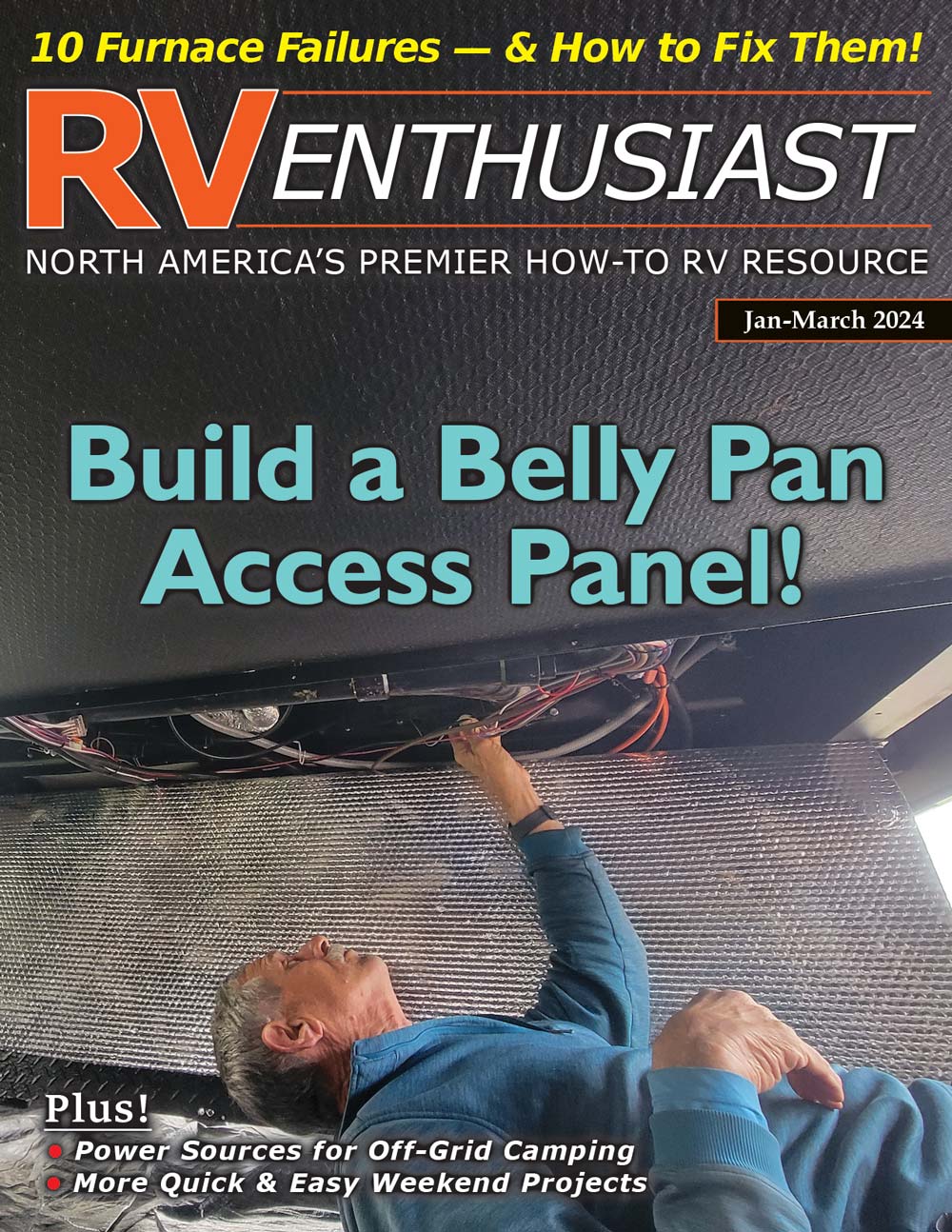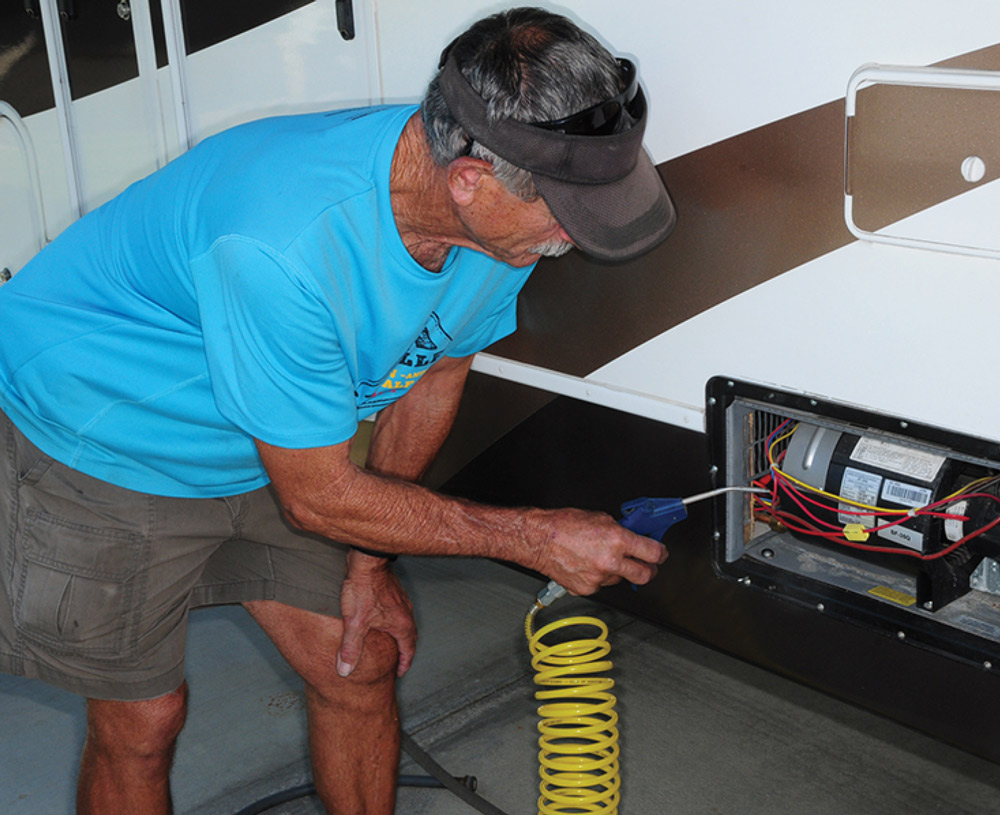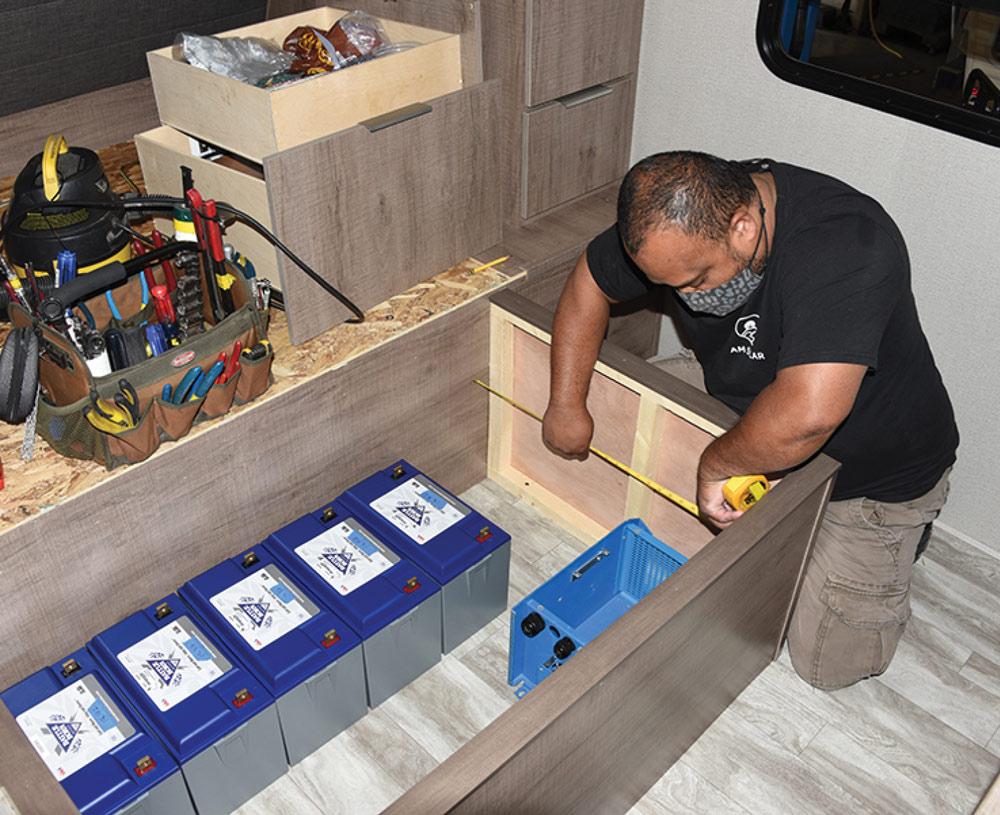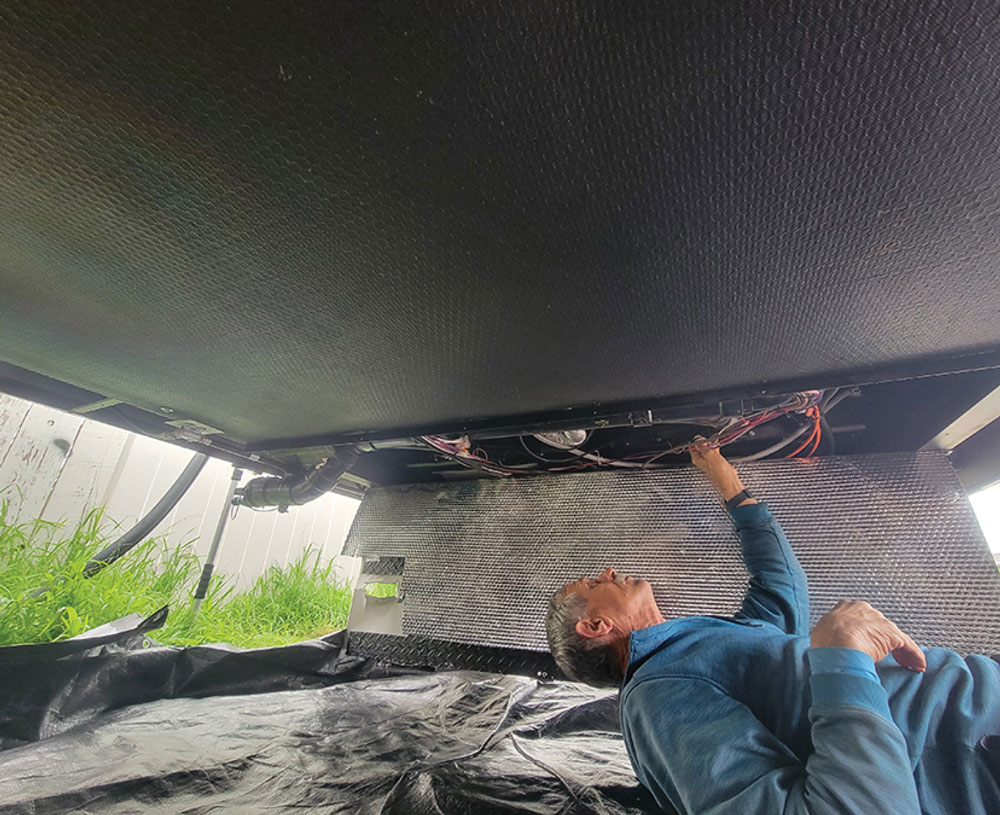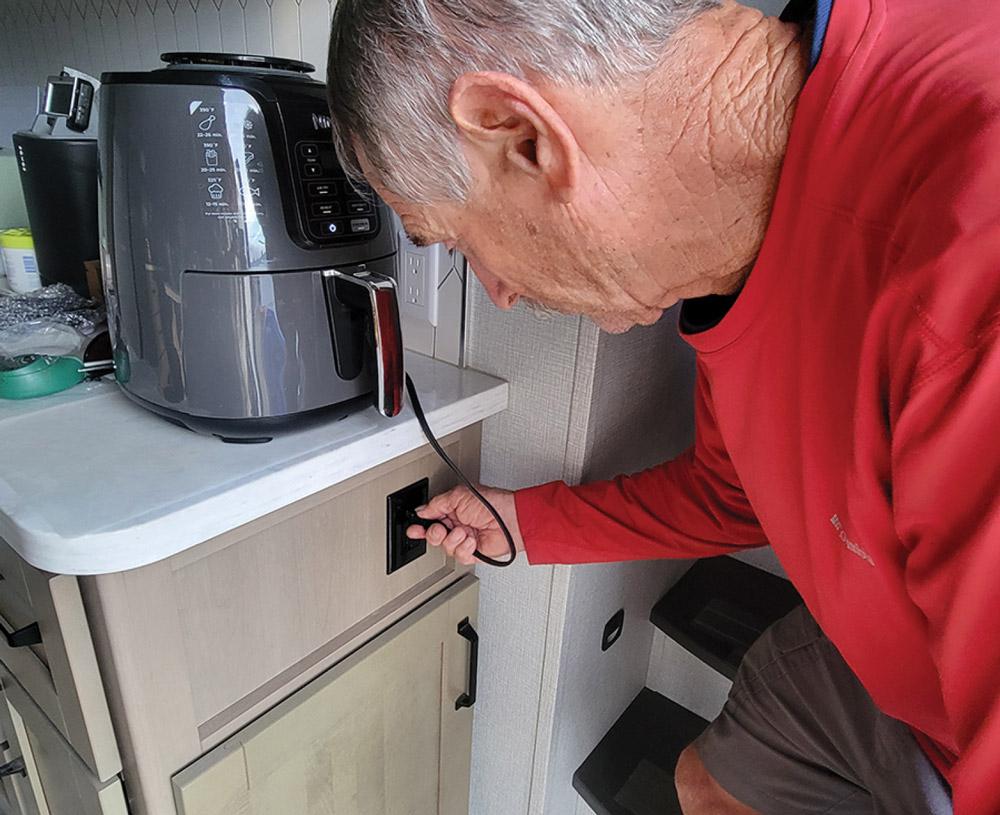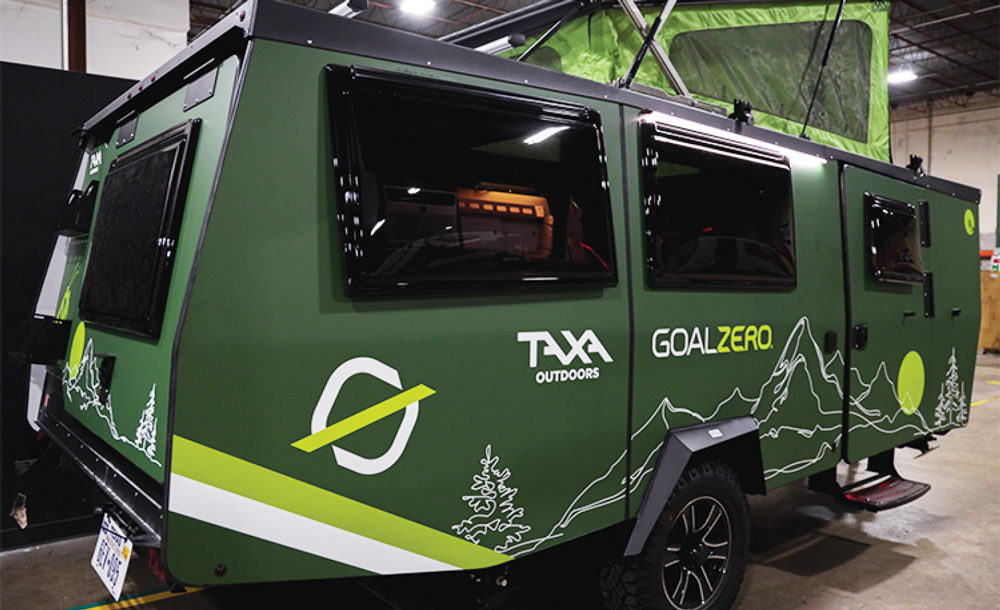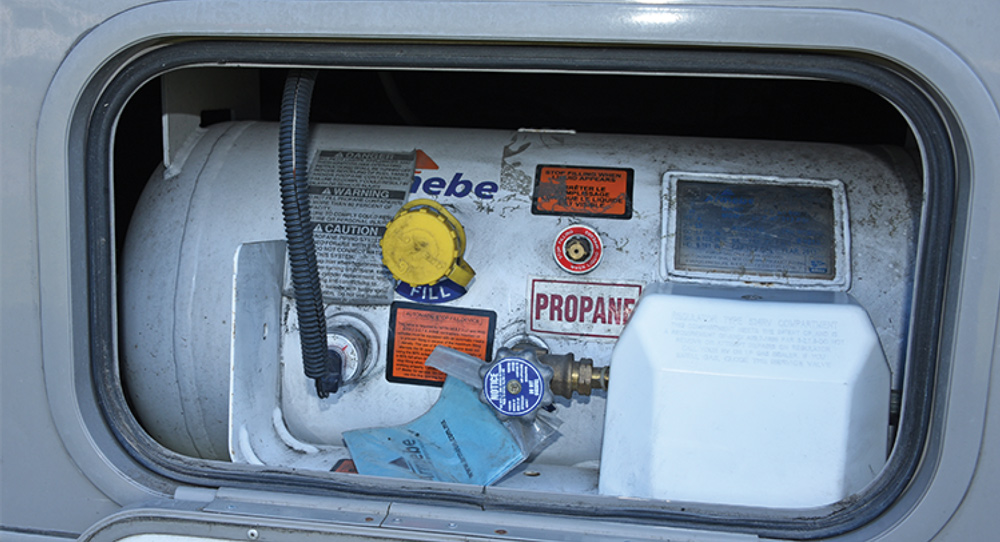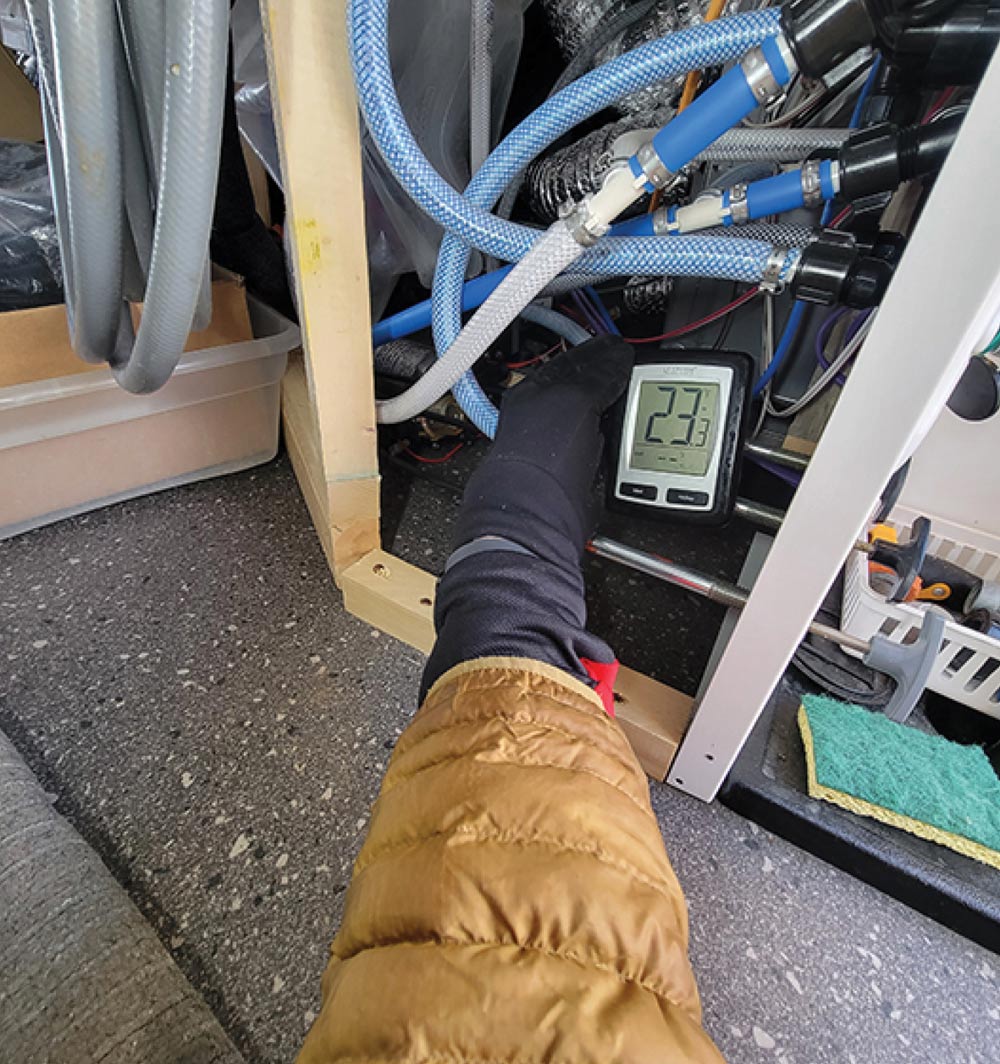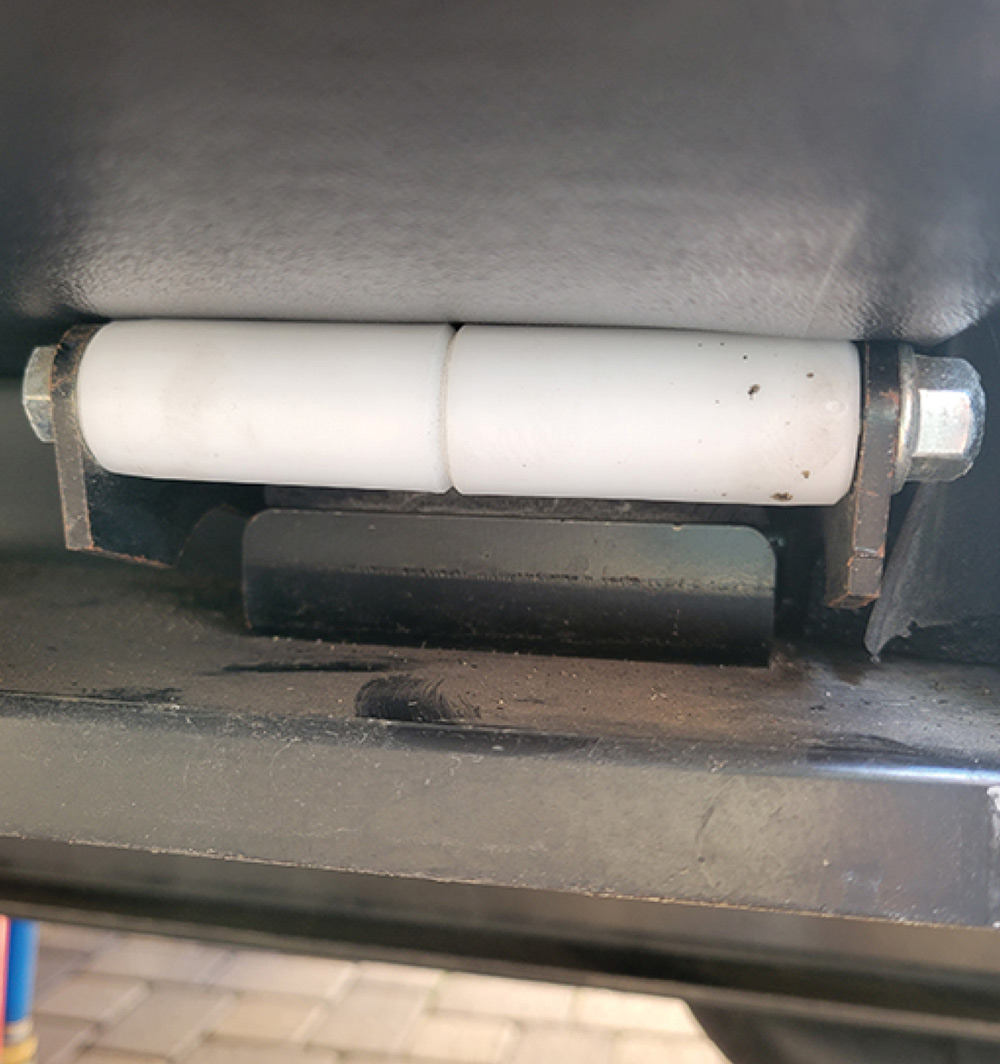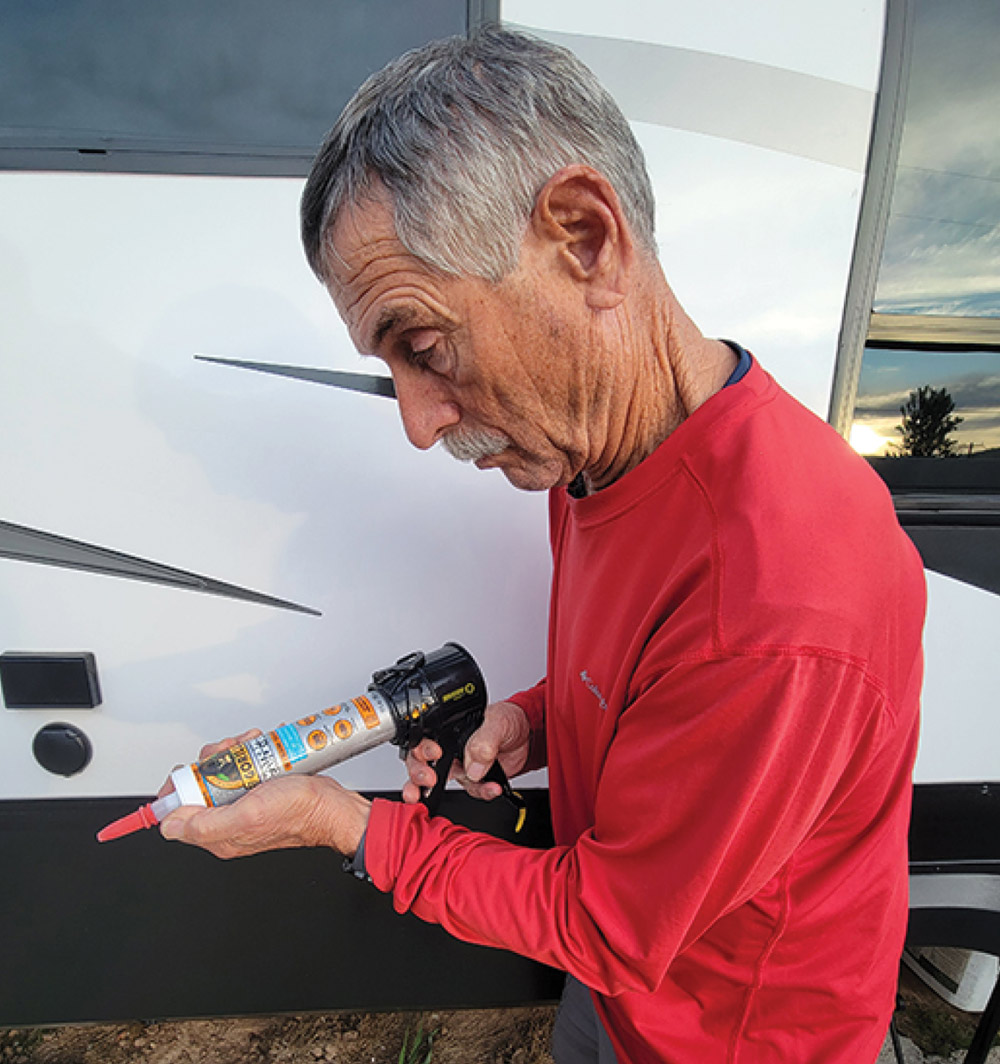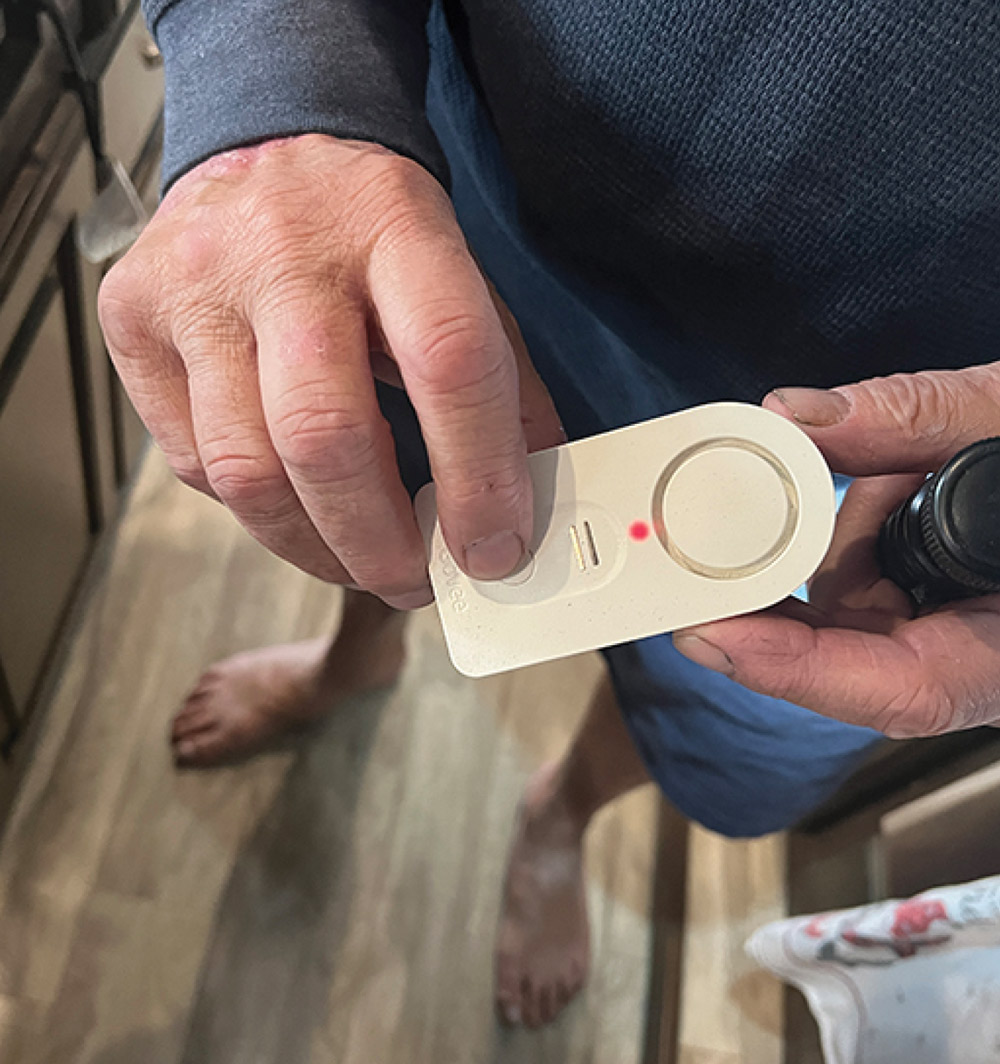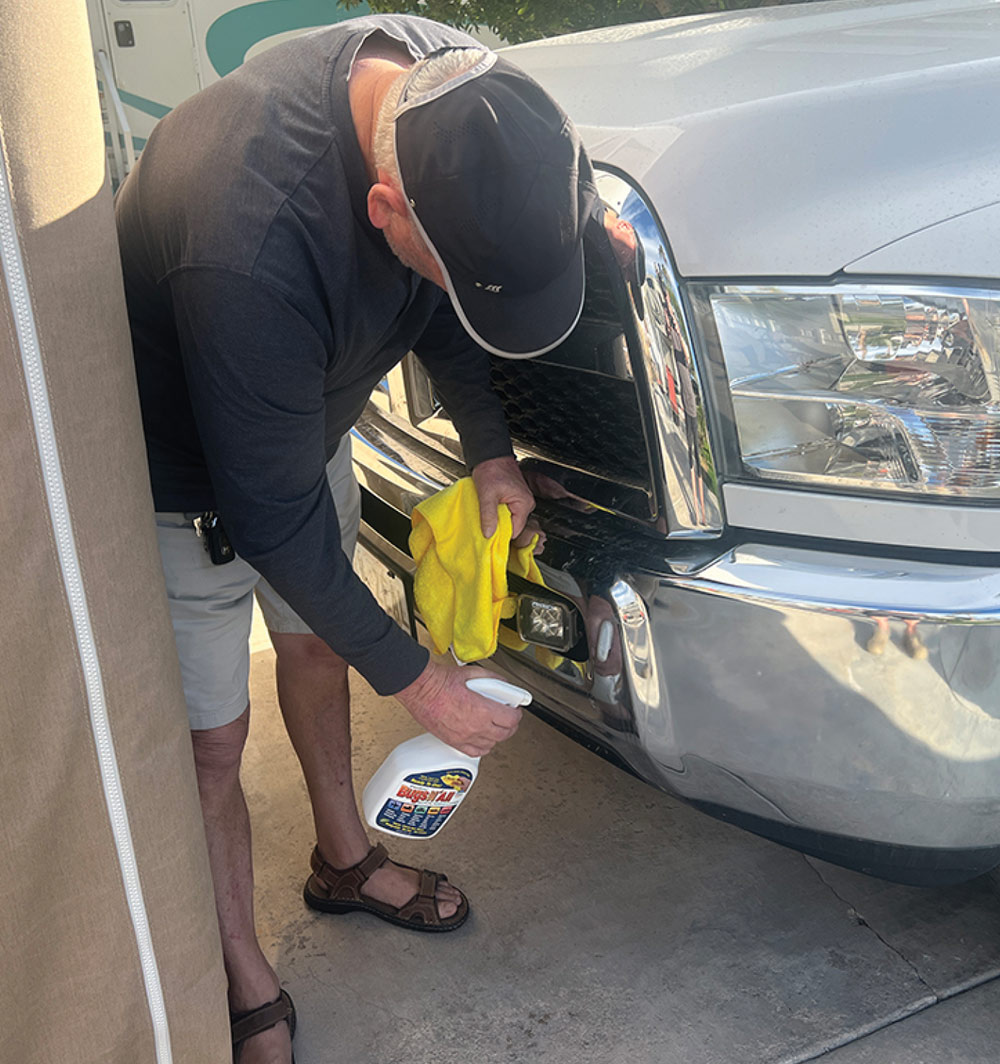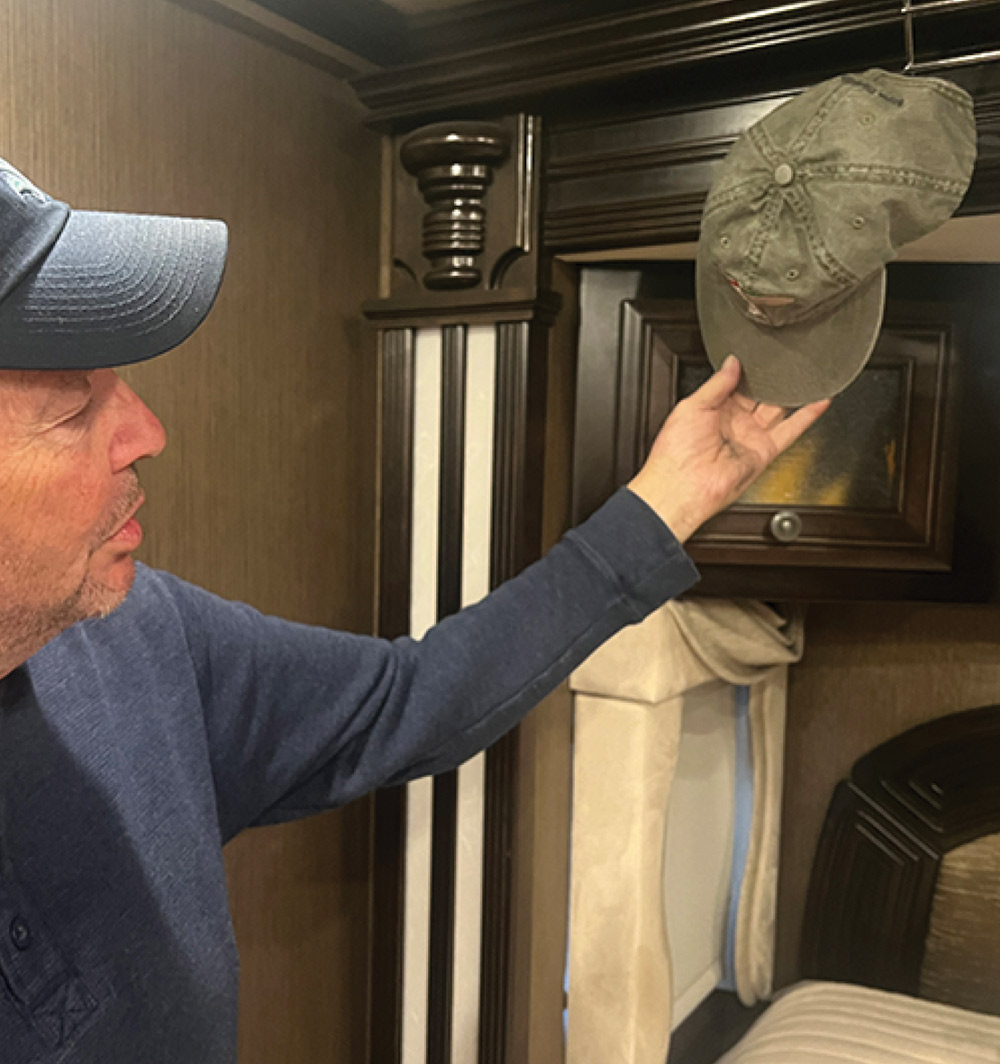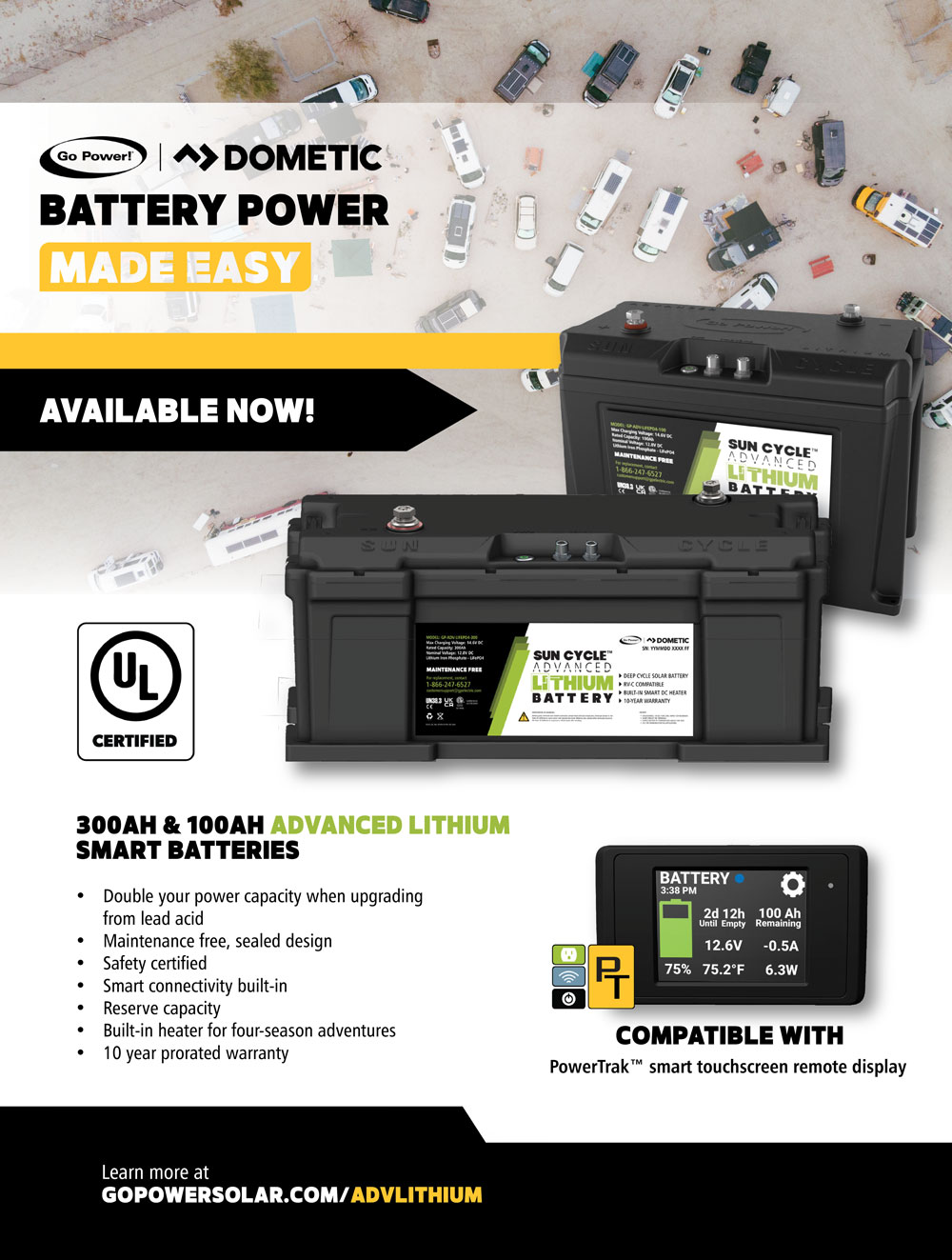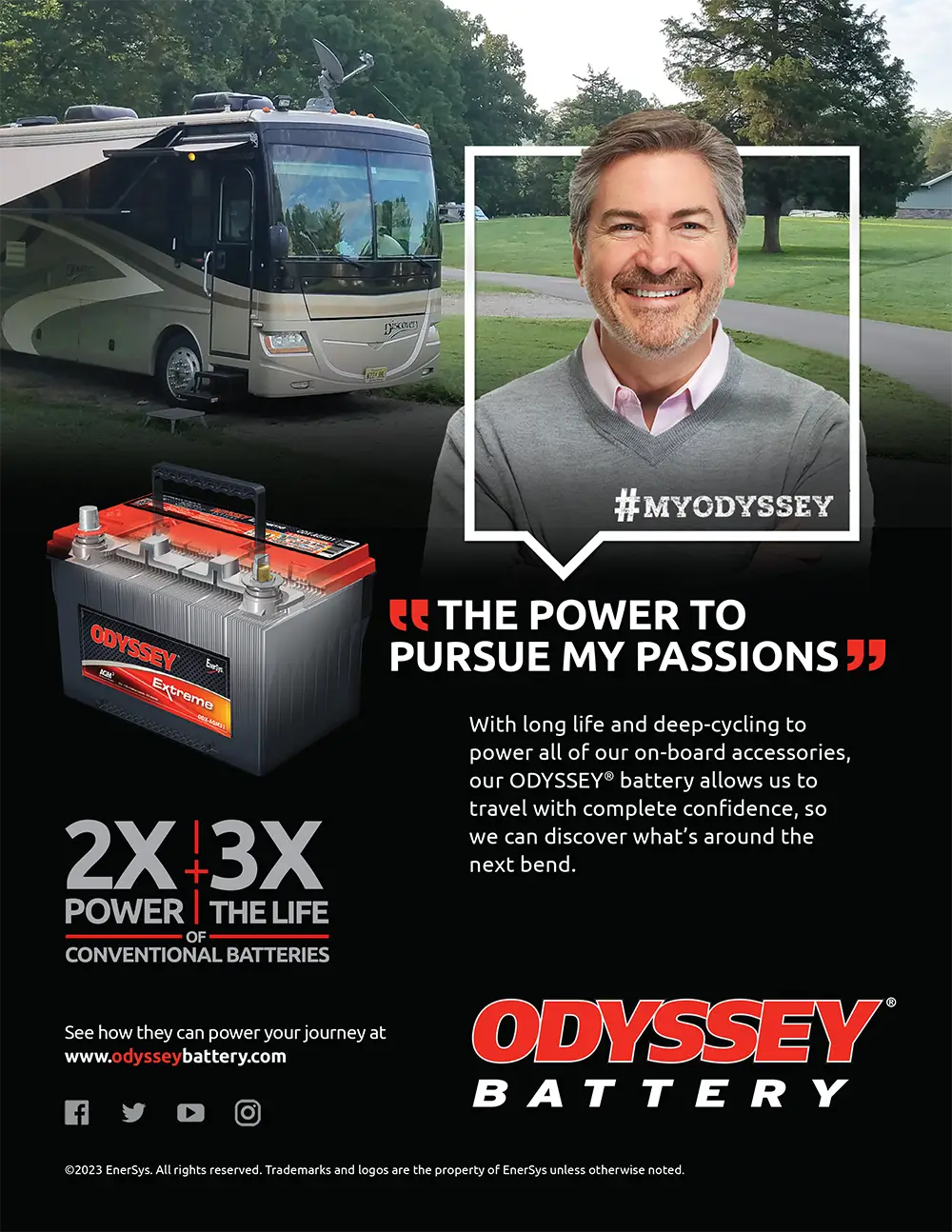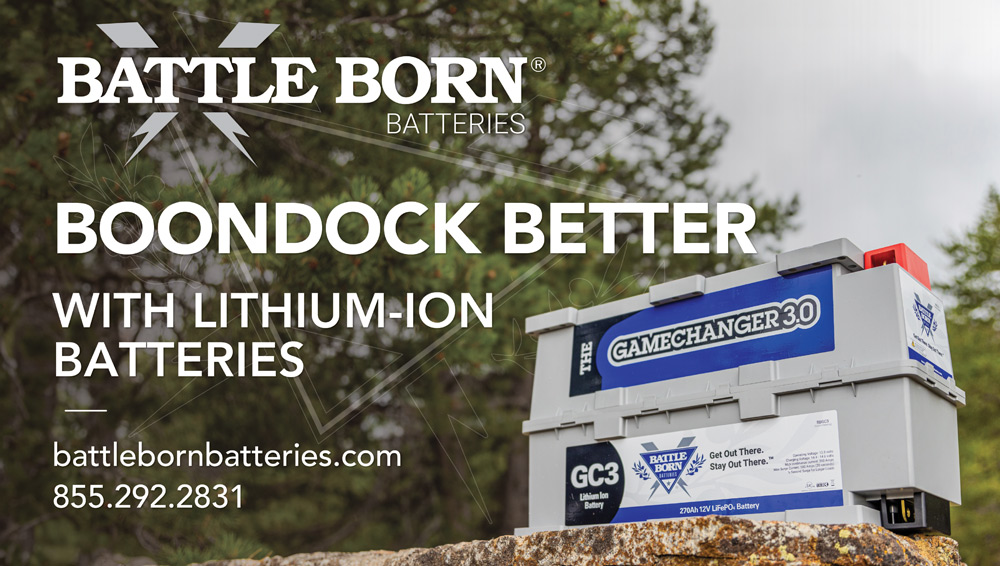Subscriber Access Only
Special Offer
Get 1 year of RV Enthusiast Magazine for just $9.99
Unlock My Offer No ThanksAlready a subscriber? Click here to access full issues.

+
Anti-Sway Bars

+
Anti-Sway Bars
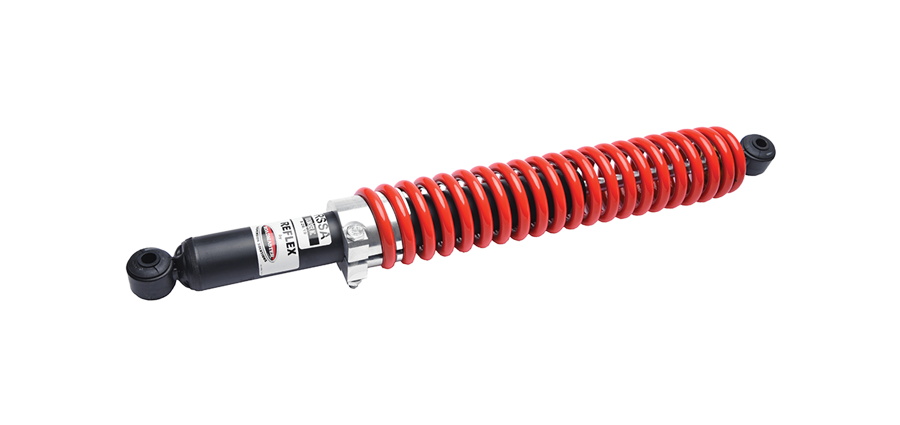
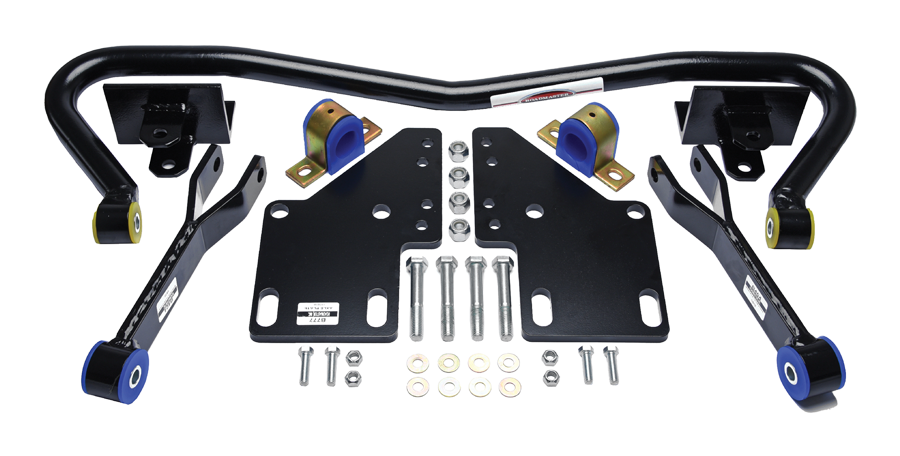
Reduces driver fatigue, increases driver confidence.
Improves handling, decreases wander.
More control in evasive maneuvers or tire blow-outs.



and Find Your Fit!

Keeping an eye on internal components and knowing what to look for when your RV furnace fails or becomes erratic can make a big difference when it comes to enjoying the interior space in comfort. Here are the top 10 reasons why furnaces fail — and how to rectify them.
There’s no denying the appeal of camping off-grid — until, that is, you wake up to no power. Our first in a series of boondocking articles takes a look at new developments in batteries and battery storage systems that make it possible to veer off-road with assurance.
There’s probably nothing less desirable than working on a dump valve that has failed while on the road — especially if the holding tank is full. Adding an access panel in the corrugated plastic belly pan eliminates the frustration of making nasty repairs when in the field.
It doesn’t matter if you camp with an entry-level travel trailer or luxury fifth wheel — there will come a time when you’re stymied by a lack of a readily accessible 120-volt AC outlet where you want it. Here’s how we added power to the galley — on a separate circuit — in a fifth wheel.


(805) 320-6909
[email protected]
EDITOR – Bruce Hampson
(574) 584-4616
[email protected]
TECHNICAL DIRECTOR
BILL GEHR
(805) 340-5015
[email protected]
ART DIRECTOR – MIKE ACCUARDI
[email protected]
26362 Douglas ave., Elkhart, in 46514
 AFFILIATE NOTICE: RVE Media Group LLC provides links to vendors and products, such as an Amazon Associates account, for informational purposes, but that may provide a commission if you purchase from that link. We often label these links with language that provides transparency if the destination is an advertiser, affiliate, or partner. Products are often provided to RVE at little/no cost for editorial testing purposes by vendors/suppliers. Under no circumstances does this affect the results of the test or install as published in RV Enthusiast. Sponsored content is identified as such directly on the content.
AFFILIATE NOTICE: RVE Media Group LLC provides links to vendors and products, such as an Amazon Associates account, for informational purposes, but that may provide a commission if you purchase from that link. We often label these links with language that provides transparency if the destination is an advertiser, affiliate, or partner. Products are often provided to RVE at little/no cost for editorial testing purposes by vendors/suppliers. Under no circumstances does this affect the results of the test or install as published in RV Enthusiast. Sponsored content is identified as such directly on the content.
PRIVACY POLICY: Our complete privacy policy can be found at https://rventhusiast.com/privacy-policy/
hen I first started rebuilding and modifying cars, there was no Internet. In some ways, that was a blessing. There’s little worse today than being stymied by a problem halfway through a repair, logging onto your favorite forum to explain your conundrum and getting a hundred or so replies — some of which tend to either back up one of a half-dozen or so competing “fixes,” while others usually include a cadre of members practicing a style of sophomoric humor most of us thankfully left in the fifth grade.
No, “back in the day” we developed our own information sources. Among my most trusted “consultants” were the guys across the counter at the local speed shop, who were only too happy to collect my weekly paycheck and dispense wisdom with my change. I was also fortunate enough to make friends with a group of guys who hung around at a machine shop in a neighboring city. The owner accepted me into the group, which meant that not only did he become a source of information but made everything in the shop available — from the typical array of engine-rebuilding machinery to a table grinder for resurfacing flywheels and a bead blaster for stripping parts. For free.
News & Notes
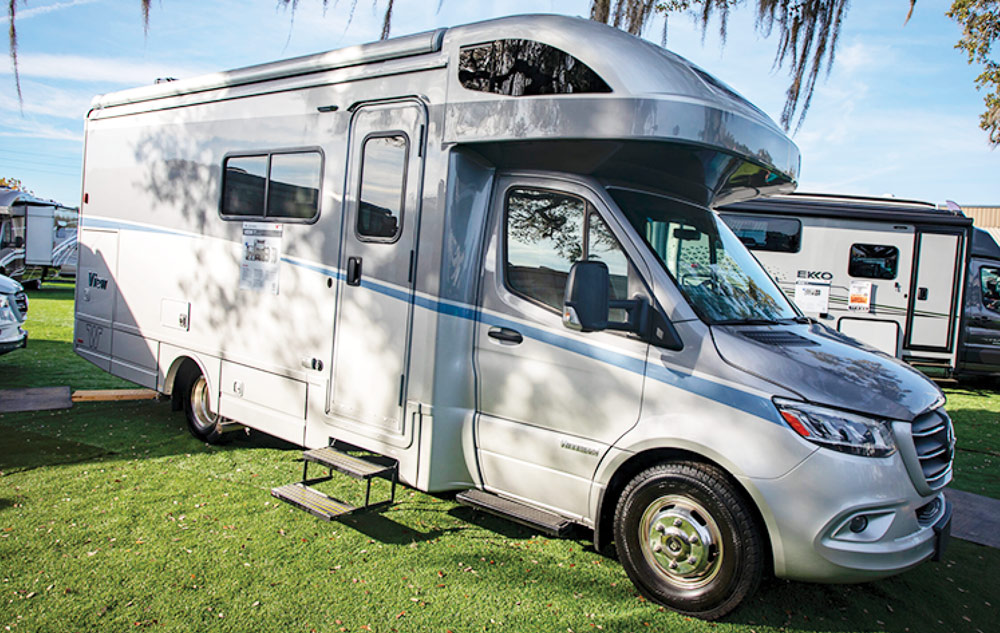
In development for two years, the Connect system — which debuted on a View 24T Class C motorhome, is, according to the company, an “intelligent RV system empowered with intuitive control that proactively manages on-board systems according to user preferences.”
The Connect development team puts it another way, calling it a “world-class experience that’s easy to use and intuitive.”
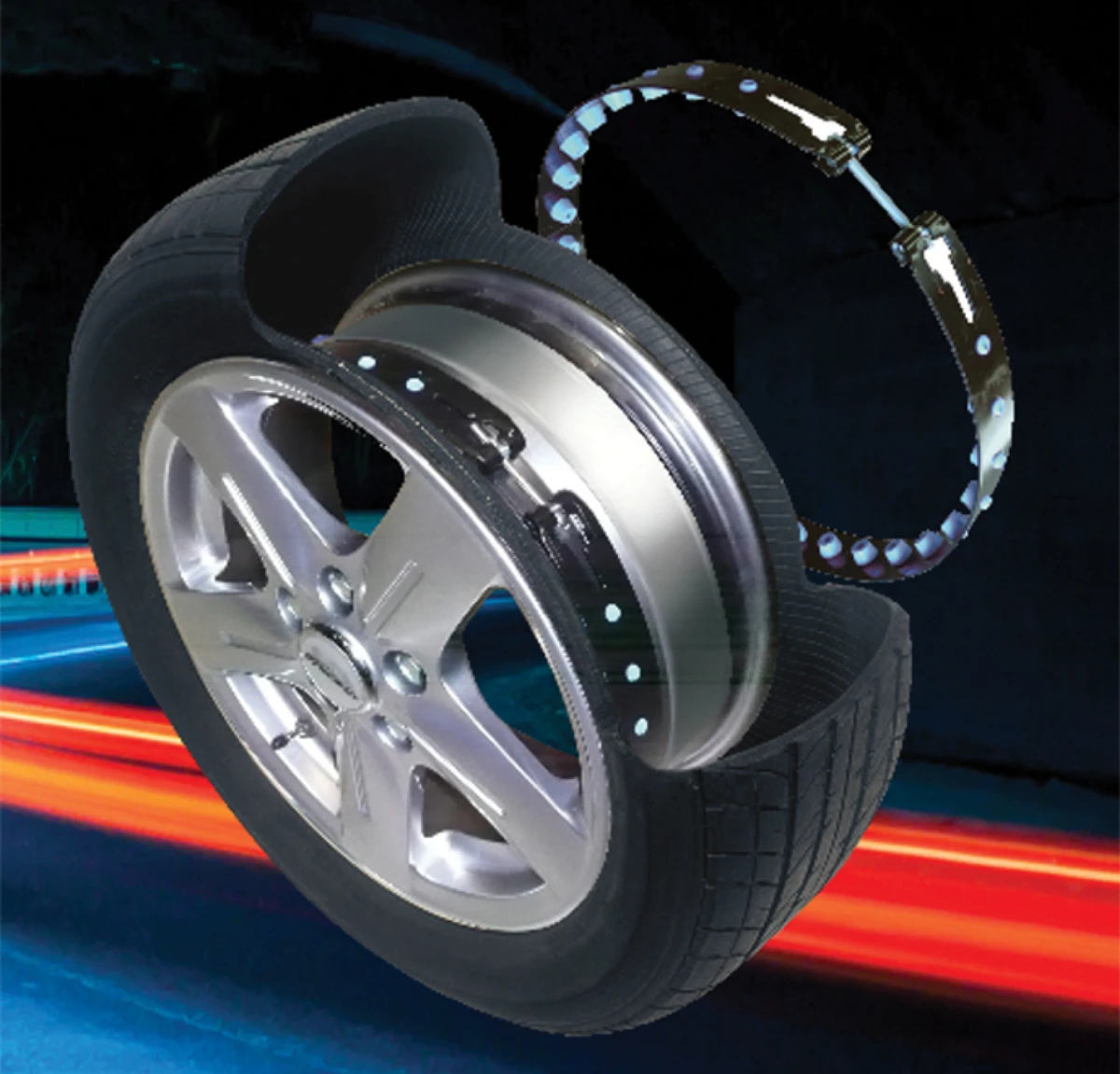
—Dean Capo
The Tyron safety bands (www.tyron-usa.com) really do improve the safety in the event of a front-tire blow out. They are not cheap, but since they only go on the steering axle, you’re just talking about two wheels. Blowouts can affect steering, braking and traction, as well as handling. With a heavy motorhome, it’s not uncommon to experience rapid deflation of the tire, which can send the motorhome off the road.
Tyron safety bands are installed in the center well of each wheel, which prevents the tire bead from coming off the wheel during a blowout or deflation. When the tire comes off the wheel, handling diminishes — and if the tire comes apart, you’ll be looking at quite a bit of collateral damage to the wheel well and other nearby areas, like the fuel filler and other trim.

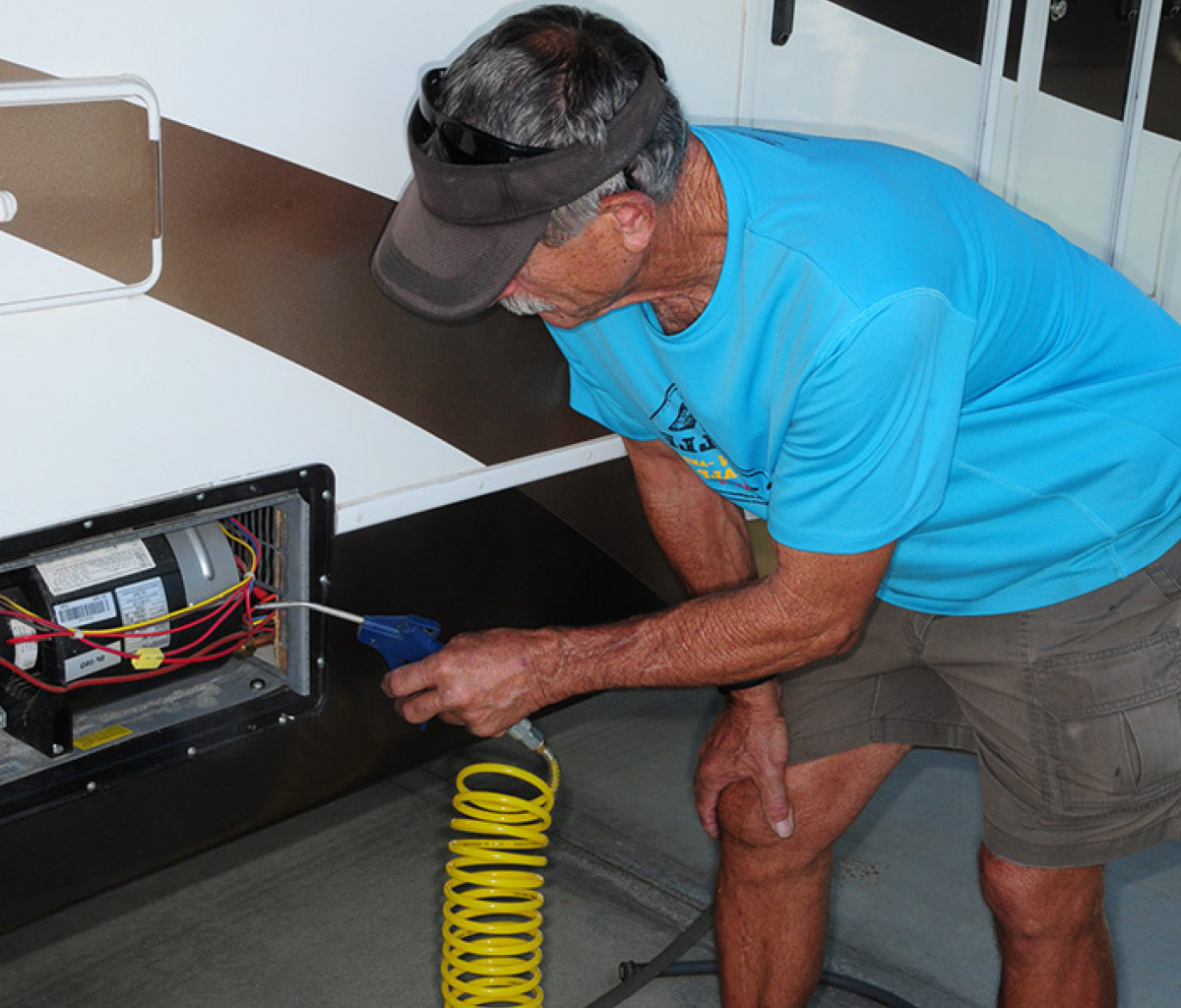
inter can be a special season to travel in an RV — and when the temperature drops, modern comfort heating systems will keep the interior cozy. Granted, there are a number of ways to warm up the interior, but most RVers rely on their LP-gas furnaces. Everything is copesetic when they work, but when something goes awry, it can be a challenge to keep occupants comfortable inside the RV. That’s why it’s important to have at least a basic understanding of what can go wrong and how to mitigate the situation — even when on the road, far from service centers.
It’s not possible to have an effective HVAC system without a source of heat. Murphy’s Law suggests that a furnace will only fail when it’s needed the most. Keeping an eye on internal components and knowing what to look for when a furnace fails — or becomes erratic — can make a big difference in whether you’ll be shivering inside a blanket or enjoying the interior space in comfort. The following applies to typical furnaces found in RVs. (Hydronic and Truma models are not covered here.)
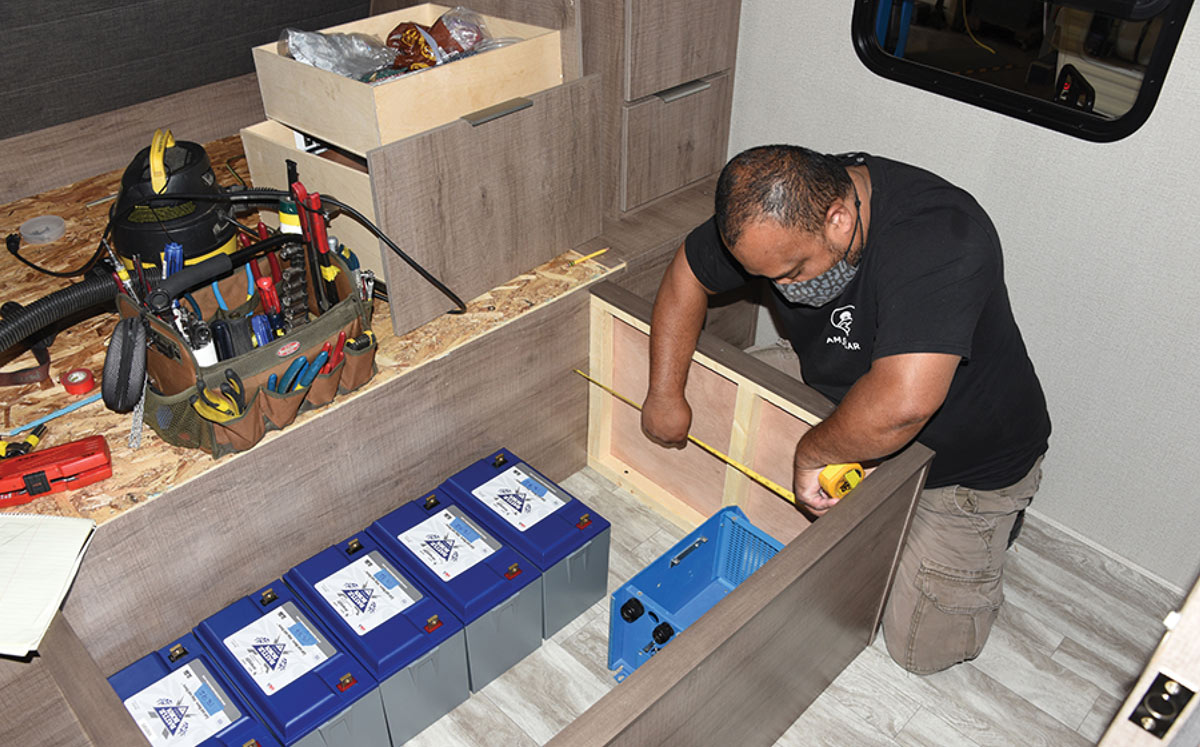

rue self-containment in an RV is not possible without a reliable and rechargeable power source.
Amazing, isn’t it, that such a simple, direct declaration can create so much confusion? There are a lot of reasons for this — and, admittedly, plenty of “blame” to go around. But whether the culprit is the outdoor hospitality industry (campgrounds) that were caught flat-footed as pandemic-fueled buyers gravitated towards camping — a bit of a reach, because no one undertakes the costly construction of new RV resorts without good reason — or simply a younger generation of RVers looking for experiences found outside a rented RV space, the fact remains that, today, batteries in RVs are under much greater loads than any time in the past because of the push to go off the grid and not give up creature comforts.
Manufacturers are well aware of this, as evidenced by the burgeoning number of units rolling off assembly lines with at least a modicum of battery-and-solar packages intended to try and keep the “lights on.” So, too, is the supplier side of the industry, which is flooding the shelves of RV and automotive parts stores with a mind-numbing number of new and increasingly cheaper 12-volt batteries embracing — at least in theory — the latest energy technology.

overing the bottom of any travel trailer or fifth wheel with a one-piece corrugated plastic sheeting protects the innards below the floor from succumbing to road/environmental hazards — plus, it provides a smooth, finished look. The downside of this belly pan is the inability to access tanks, valves, pipes and wiring without taking a large section down, which can be a big project and most likely messy. Case in point is having access to the cable-operated dump valves that have a propensity to fail — usually at the worst time.
There are several scenarios that can develop, the worst being when you pull the dump valve handle, located in the utility compartment or under the rig, and the cable pulls out without opening the valve. The only way to get the valve open at this point is to either reattach the cable, if possible, or pull the valve open temporarily with a Vice-Grip pliers, but that requires access to the valves. I originally tried dropping a small section of the corrugated plastic to peek in and locate the exact area of the valves, but access was restricted and compounded by a rat’s nest of wires and pipes.


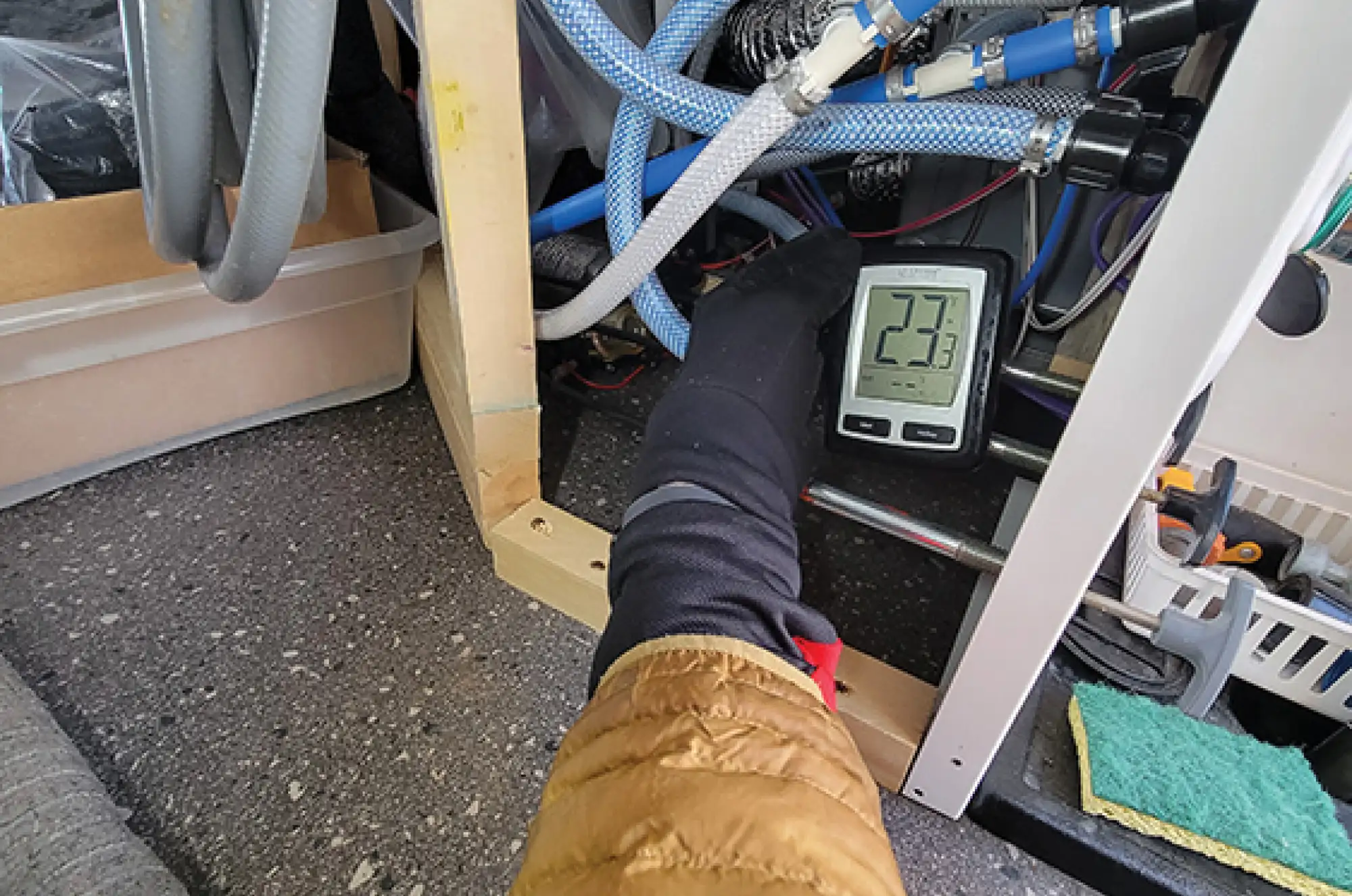
hen my tankless water came on recently in the wee hours of the night in order to protect itself from freezing ambient temperatures, the reality of winter set in. Fortunately, the water heater is able to protect itself automatically — but there are other vulnerable points that need attention to prevent damage from below-freezing temperatures. For example, the plumbing behind the water manifold in the utility bay or in the area around the pump. And, of course, any water lines that are not protected by furnace heat and/or additional insulation can be damaged.
While I use wireless probes in exposed areas to monitor temperature, I wanted a device to sound an alarm before the area was subject to freeze-ups. In today’s world there are specialty devices for just about everything, so I was not surprised to find one made by Kidde, a well-known company that markets smoke and carbon monoxide detectors. This product, interestingly, also monitors the surrounding area for water leaks. The device can be found on Amazon by searching “Kidde WiFi Water Leak Detector & Freeze Alarm Alexa Device, Smart Leak Detector for Home with App Alerts, White.” It’s available on the Kidde storefront (kidde.com/home-safety/en/us/) and other websites with prices starting at less than $30.


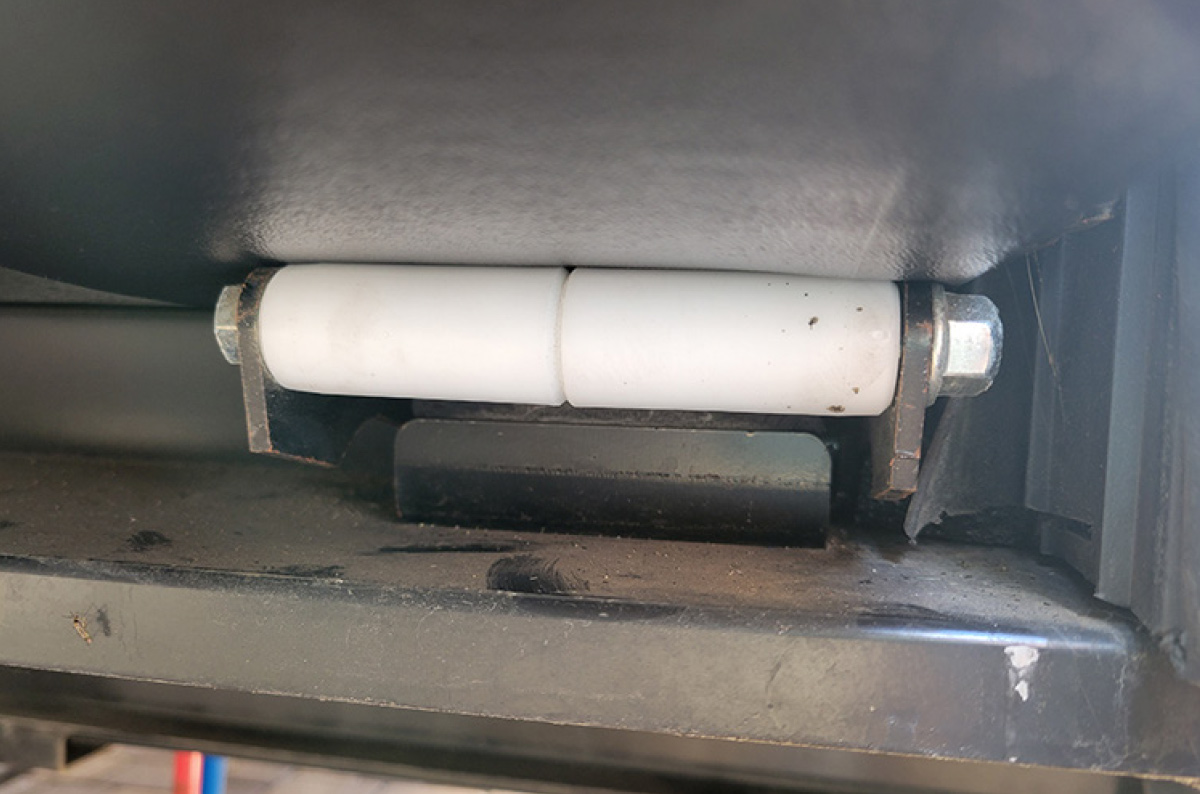
lideout rooms have evolved tremendously since their inception years ago, and while they aren’t completely fault-free, for the most part minor maintenance will keep them functioning as intended. One issue they are susceptible to, though, is when the bottom of the slideout catches on something while moving in and out. Warping of the wood or even an errant screw or small rock can cause problems — and in most cases, the result is damage to the waterproof covering underneath the slideout room. Sometimes, the main floor can also be scratched or even gouged.
Removing the entire slideout to replace the material is a big job — and making spot repairs with tape (sorry, duct tape fans) rarely works. Adding skids to the bottom of the slideout, on the other hand, is great preventative medicine. After a friend found slideout “skis” online and I installed them, I was a believer.


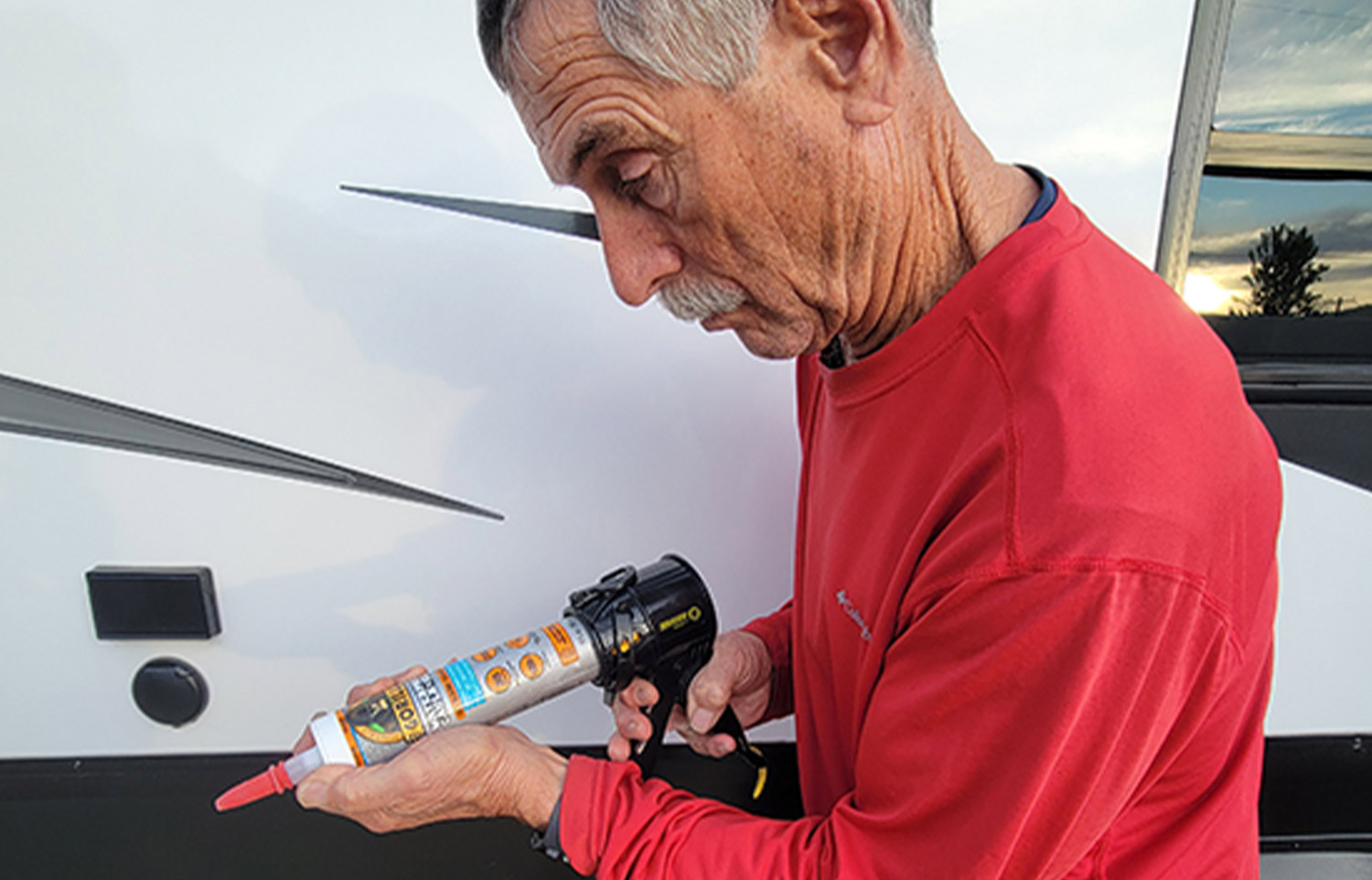
ost RV service technicians will tell you that a good caulking gun is indispensable. Just look around any RV and you’ll find countless places where a bead of sealant makes the difference between a watertight interior and one that is plagued with leaks. An ugly looking bead of sealant is not (or shouldn’t be) an option — and even though many sealants are clear or blend in with the exterior color scheme, poorly placed sealant stands out like a sore thumb.
Resealing the roof seams and accessory flanges, as well as other places throughout the exterior that have weathered over the years, should be part of a regular maintenance routine — so having the right caulking gun is paramount. There are many types of caulking guns on the market, from the simplest (and cheapest) to more elaborate models that provide better control of the sealant. There’s nothing exotic about a caulking gun, so inventing a “better mousetrap” didn’t seem like it was on the horizon. But someone has done it — and the tool is called a “SiliGun Compact 4” (siliguns.com).


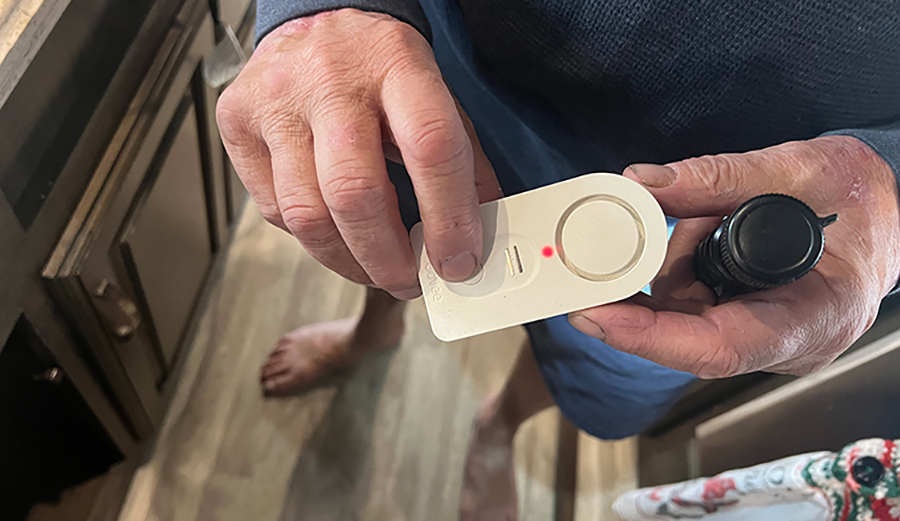
hen leaking water goes unchecked in an RV, the results can be disastrous. If you don’t find out about a leak until water drips on the ground — or pours out the entry door — it’s likely too late. You can prevent an expensive clean-up by taking a proactive stance and installing inexpensive leak detectors that can give you advance warning before things get out of control.
There’s a proliferation of such devices on the market — they’re well-known among folks who have owned a brick-and-mortar house with a basement prone to flooding — and if you search the Internet, the choices are extensive. My guess is that most will do the job, but when a friend praised the performance of the Govee water sensors he’s used for some time, that’s all I needed to make a good choice. It’s all about experience with products and reviews these days.


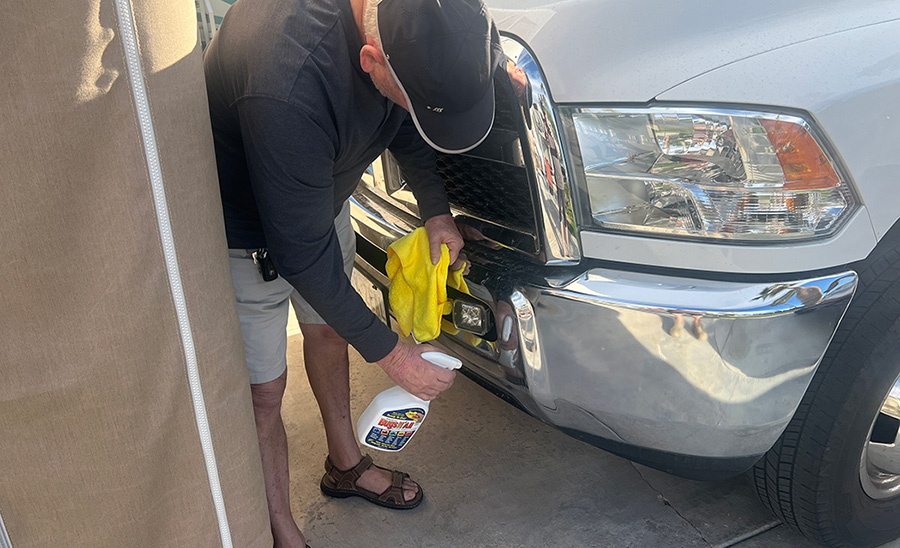
nyone who has traveled through different regions of the country knows that some places tend to be more “buggy” than others — but no matter where you travel, stopping for any length of time means dealing with bug splatter on your rig.
Over the years, products designed to remove bugs have come and gone; some worked, and some were snake oil. My go-to product for cleaning the mess has long been a Bugs Off Pad (formerly called “The Love Bug Eraser”), which works great with just plain water and a little elbow grease (bugsoffpads.com). Last summer, though, I added another “weapon” for removing squashed bugs to my arsenal of cleaning products: ProSol Works Bugs N All Multi-Use Vehicle Cleaner (bugsnall.com). The combination of the Bugs Off Pad and Bugs N All cleaner makes the job even easier — especially if the bug splatter is allowed to bake on the surface for a while.


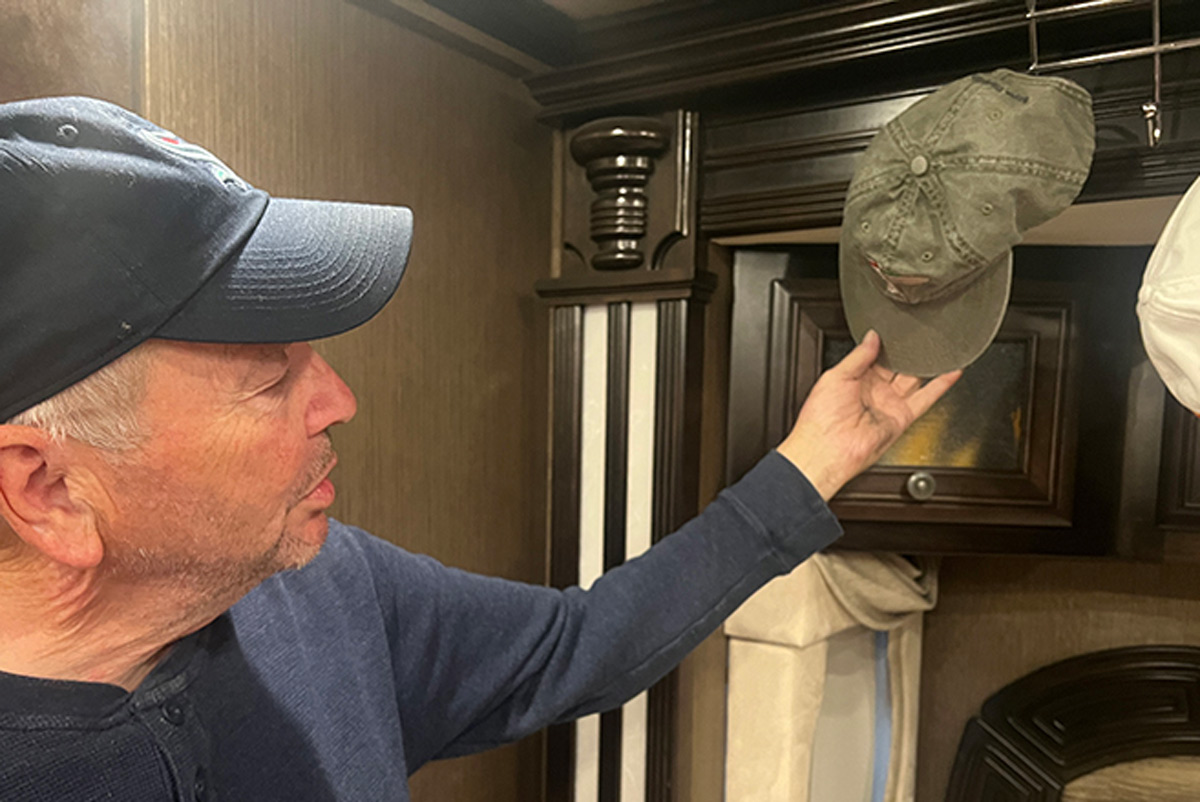
ne of the challenges of RV ownership is finding places to stash stuff. Over time, closet and drawer space seems to shrink as more items are brought on board. Longtime friends and authors, Bill and Jan Moeller, who spent most of their lives in an RV and are now in the RV park in the sky, perfected the art of managing belongings in confined quarters. I learned a lot from the Moellers, who sometimes had radical ideas like removing book covers to reduce weight and to always discard an equal-size item to make room for another.
The Moellers stuck to their regiment and wrote books on how to fulltime, which have become classics (just search “Bill and Jan Moeller” and you’ll find sources for their published works). The Moellers were masters at finding cubbyholes. For those less enamored with this topic, there are simple ways to improve storage, like adding over-the-door hooks.
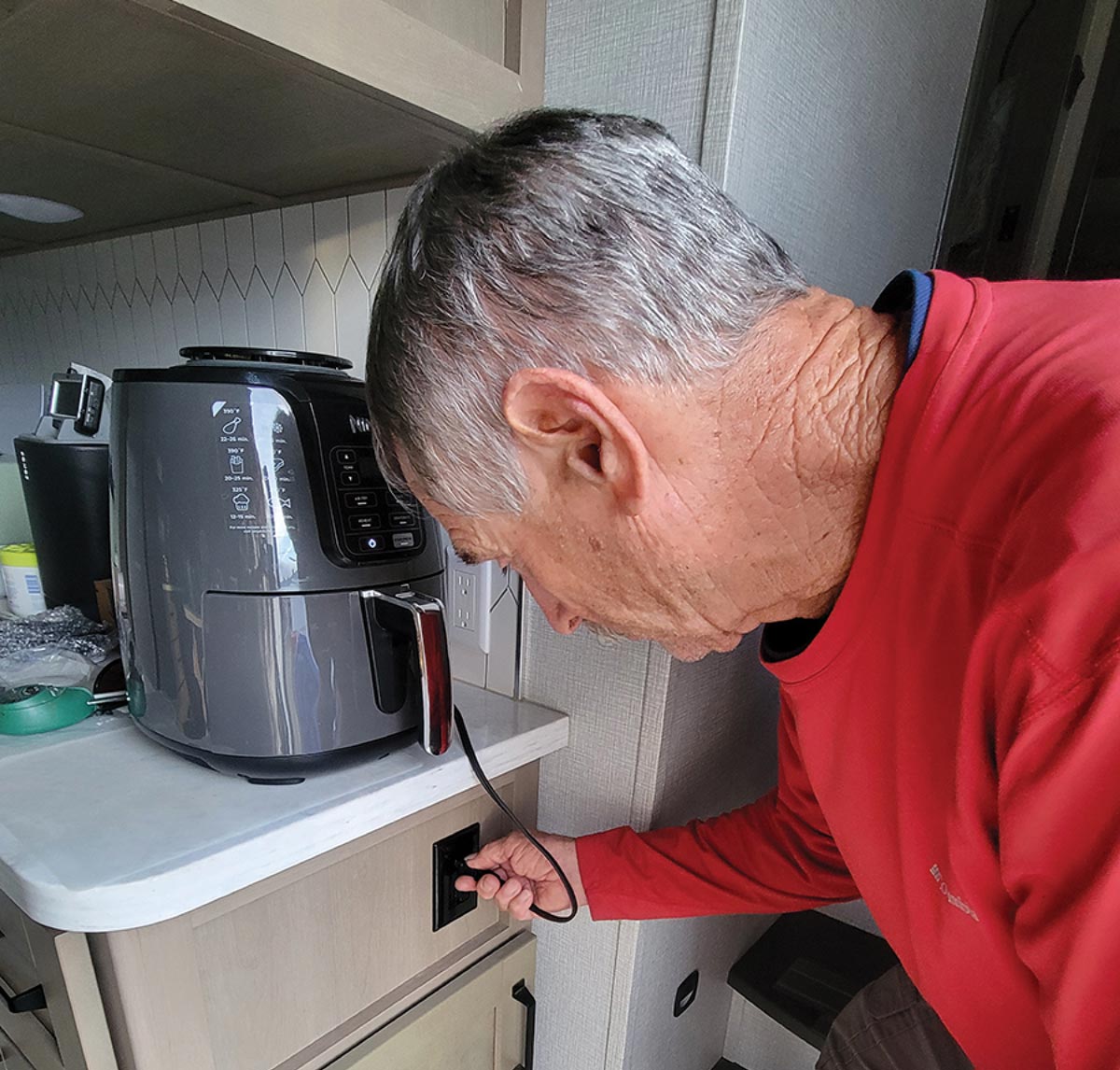

ver the years, RV owners have become spoiled with the proliferation of electric appliances. From the health benefits of cooking in an air fryer to baking a Thanksgiving turkey or using a portable electric heater, RVers have become reliant on 120-volt AC powered appliances — and the industry has responded with a greater selection of all-electric RVs.
For those of us without an all-electric RV, however, ganging 120-volt AC outlets can make it difficult to operate multiple appliances at the same time. For example, in my fifth wheel, the electric supply in the kitchen and the hutch was totally inadequate. All the outlets were tied into a single 15-amp breaker, which made it difficult to run two appliances at the same — unless power consumption was limited to maybe 700-800 watts. It didn’t take long to realize that I needed to add another circuit in the hutch area.



